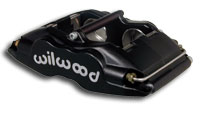Forged Billet 4-piston Superlite Caliper
Highlights:
The Superlite caliper series has set the
standard for many years in short track, late model, modified
and open wheel competition. It has also enjoyed prominence in
a variety of road-race, off-road, rally and sport driving
applications. The Forged Billet Superlite (FSL) is
the newest innovation to this series from Wilwood. New and
adaptive technologies have been applied providing substantial
improvements in strength, fluid volume displacement, and
overall performance.
 Forged Billet Superlite calipers use
the 7420 type bridge bolt brake pad. The full range of
PolyMatrix pad compounds is available to match brake response
and heat range to any application.
The FSL body design is a highly efficient
product of computer generated solid modeling and stress
analysis technology. Each caliper features closed end bridges
with a radial transition to the piston body housings. The
elimination of machined steps and sharp shoulders in this
critical area provides a measurable increase in overall body
strength and resistance to deflection under load. Center
bridge bolts replace cotter pins to provide additional support
and allow quick access with positive brake pad retention.
Clamping force, structural deflection, and volume displacement
tests have proven the superior strength and efficiency of the
FSL. On-track testing has proven driver satisfaction. The
bottom line is better stopping power with less pedal travel. Forged Billet Superlite calipers use
the 7420 type bridge bolt brake pad. The full range of
PolyMatrix pad compounds is available to match brake response
and heat range to any application.
The FSL body design is a highly efficient
product of computer generated solid modeling and stress
analysis technology. Each caliper features closed end bridges
with a radial transition to the piston body housings. The
elimination of machined steps and sharp shoulders in this
critical area provides a measurable increase in overall body
strength and resistance to deflection under load. Center
bridge bolts replace cotter pins to provide additional support
and allow quick access with positive brake pad retention.
Clamping force, structural deflection, and volume displacement
tests have proven the superior strength and efficiency of the
FSL. On-track testing has proven driver satisfaction. The
bottom line is better stopping power with less pedal travel.
The superior strength of this innovative new
caliper is combined with proven performance features from
other Wilwood designs. Each caliper is equipped with Wilwood's
replaceable SRS stainless steel bridge plates. SRS plates
eliminate the bridge wear caused by pad gouging and extend the
service life of the caliper body. The spring-loading action
of the SRS plates also eliminates pad rattle and dampens the
vibration harmonics that contribute to squeal under braking.
Other standard Wilwood features include high-temperature,
square faced o-ring seals for positive sealing, controlled
piston retraction, and long service life in high heat
conditions. Stainless steel pistons are used to resist
corrosion and retard heat transfer from the pads. Fluid tubes
are vibration dampened to resist stress fractures and reduce
damage caused by track debris. Two-piece bleed screw
assemblies provide long, reliable service life and are easily
replace if necessary.
The most noteworthy feature of this new caliper
design is the forging. Each body is stress-flow forged from
premium grade aluminum alloy billets. Stress-flow forging
re-aligns the metal's internal grain structure to flow within
the contour of the caliper body. This process eliminates the
stresses and interruptions to the internal grain structure
that occur when machining a straight block billet. Simply
stated, there is no better way to build a stronger aluminum
caliper body.
Caliper Dust Boots - why some brakes use them, and some do not.
This is a rubber concertina style boot which snaps into the
caliper around the piston or pistons and onto the piston
protrusion itself. This bellows configuration allows the
piston to move in and out of the caliper without contamination
from the environment. Road grime, dirt and especially moisture
can corrode production type caliper pistons leading to
premature failure of the piston seals rendering the caliper
inoperable.
Vehicle manufacturers typically design their products around a
minimum criteria list which almost never includes special
materials for components such as caliper pistons. Many
production style caliper pistons are therefore aluminum or other
easily corrodible metals for obvious reasons, not least of which
is cost. It is less expensive by far to make aluminum pistons
and rubber boots than to make stainless steel pistons for
example. A huge percentage of production car calipers HAVE to
have dust boots or they will not last to the end of the
warranty.
Aside from some of the obvious weight and capacity drawbacks of
production calipers, dust boots can be a hazard to high
performance drivers. Brake components are designed to convert
kinetic energy (inertia of the moving vehicle) to heat energy
and then dissipate that heat. The heating and cooling cycle
occurs with higher frequency under spirited, or race driving
conditions where it is not unusual to develop enough heat to
make rotors glow red hot. Radiant and conducted heat developed
under hard driving conditions can easily heat the calipers to
the point where the brake fluid boils and the boots burn. Dust
boots are not installed on true racing calipers.
The best solution for safe and reliable high performance
calipers is to eliminate the rubber boots and build pistons from
good quality, non-corroding stainless steel. Such calipers
are built by Wilwood Engineering and other quality companies.
Precision Brakes Company has been supplying Wilwood calipers for
high performance street and race use for nearly 19 years without
complaint. Our experience has been that companies who do build
aftermarket calipers with dust boots make an issue of this fact
to justify the exorbitant cost of their products.
|
BUILD DETAILS OF THE SUPERLITE 4-PISTON CALIPERS
|
There are currently no
products
in
this category.
|
